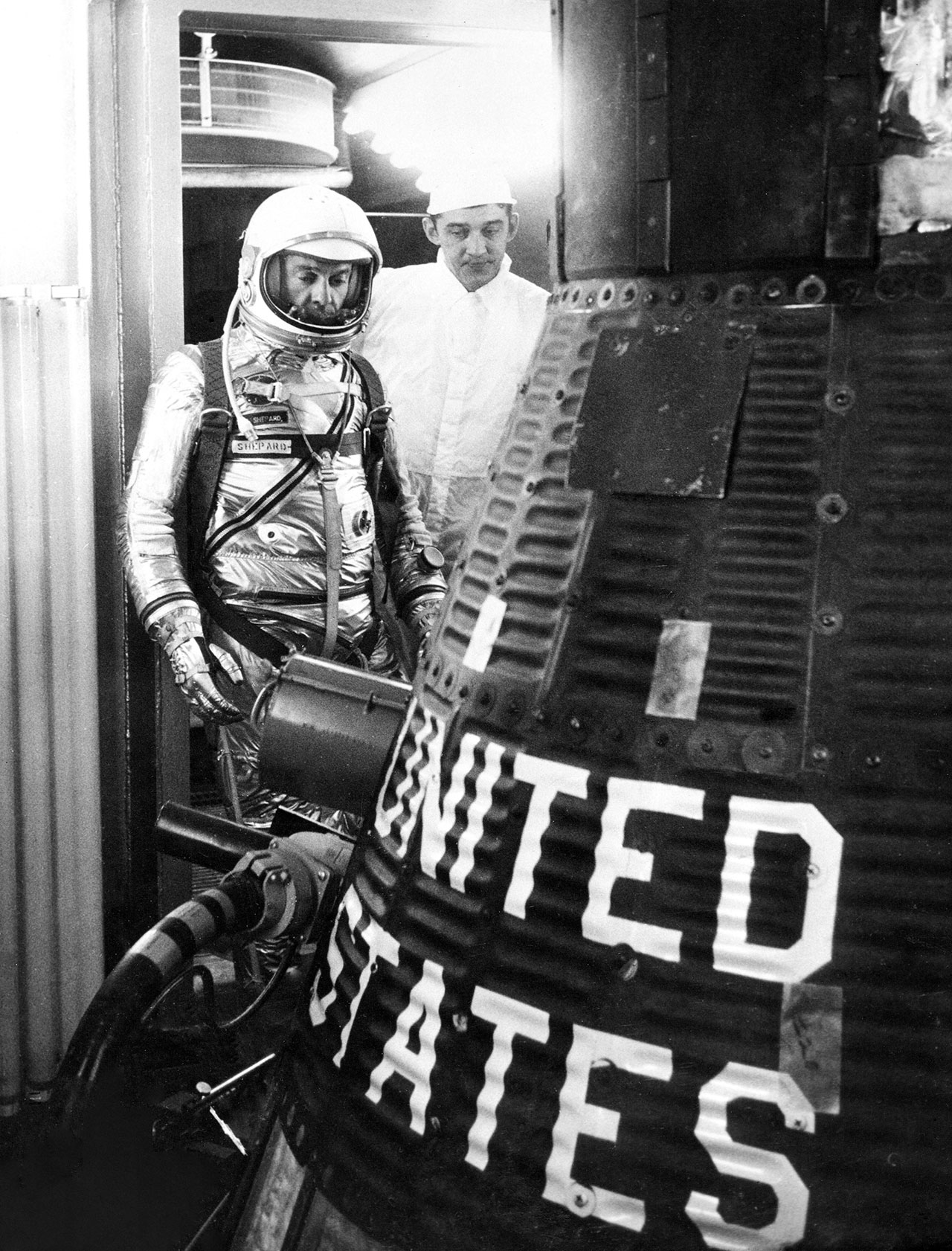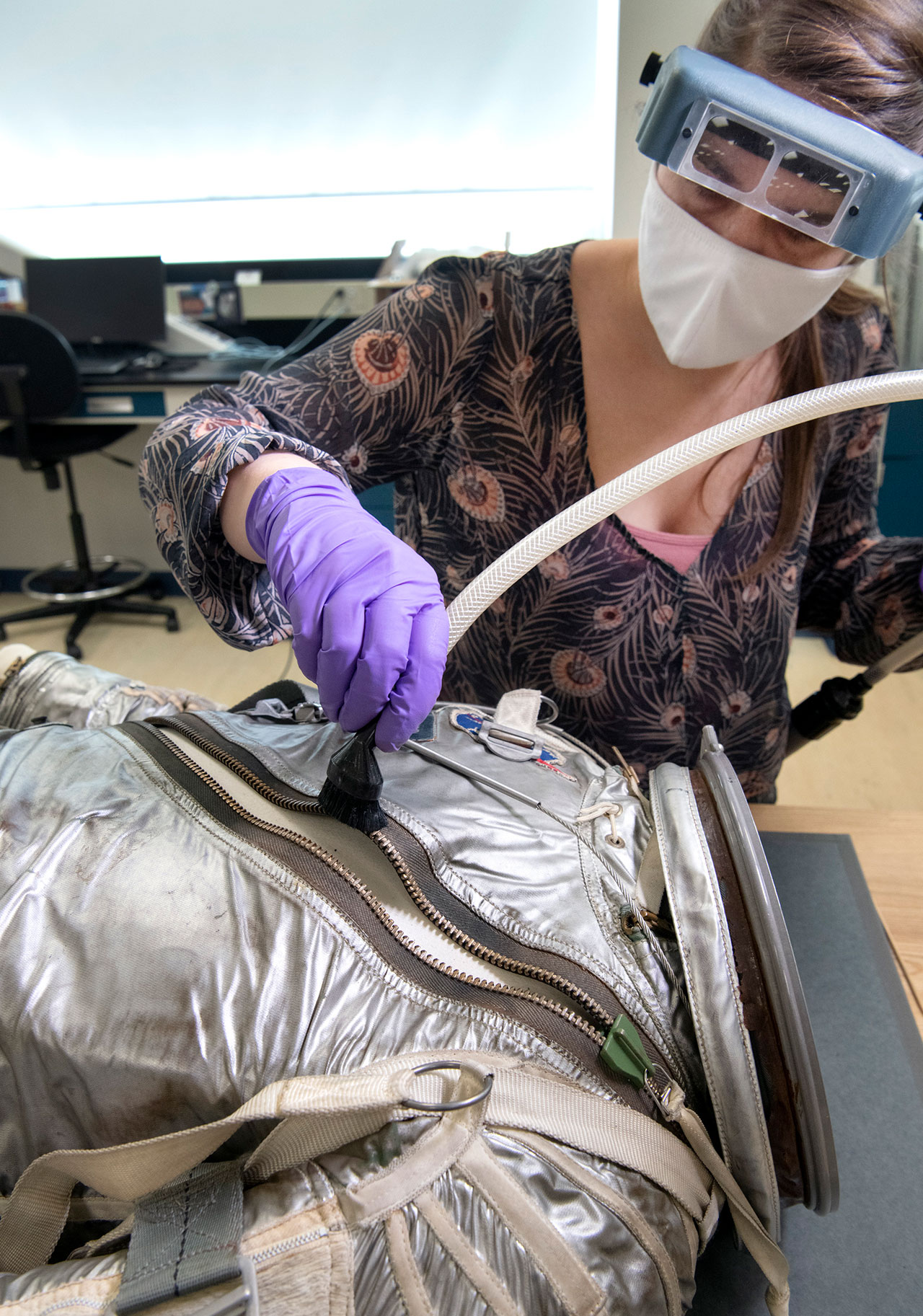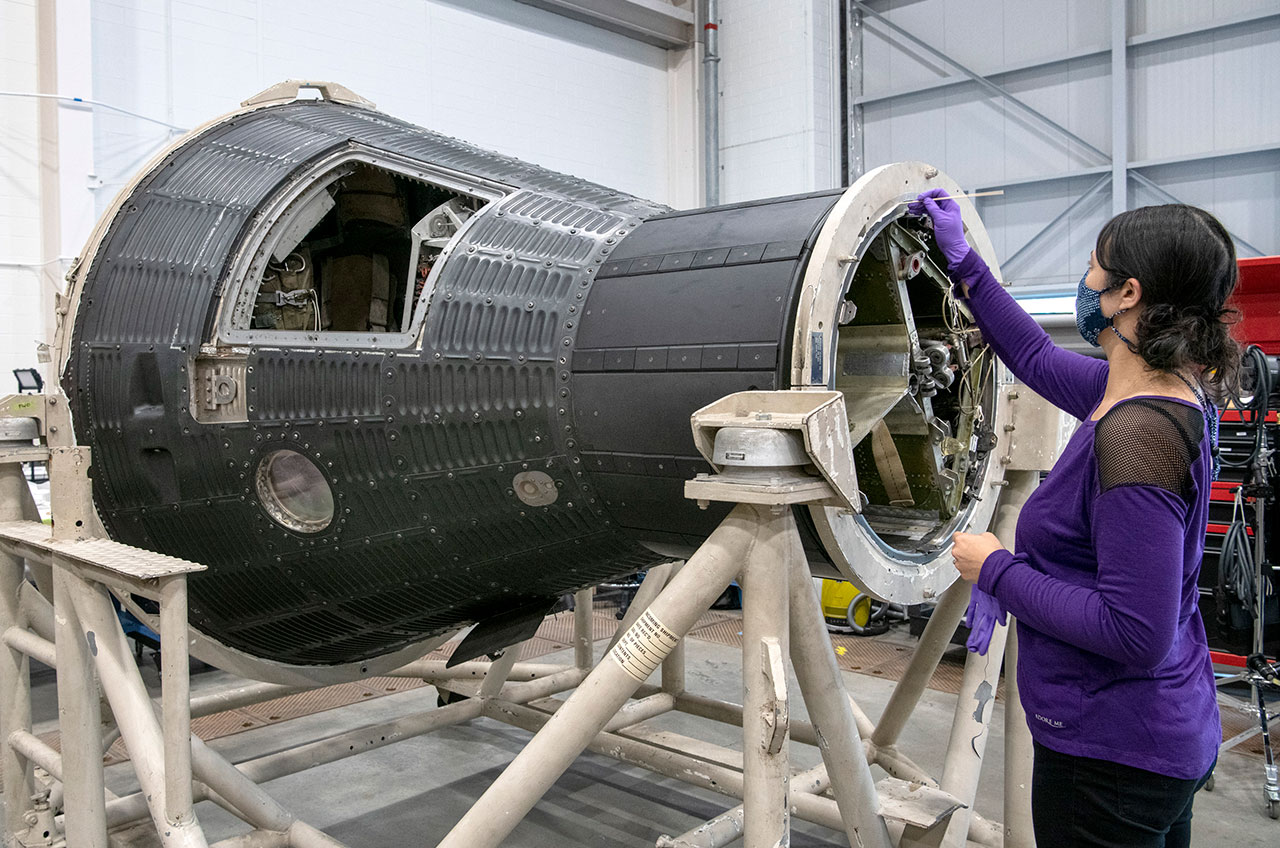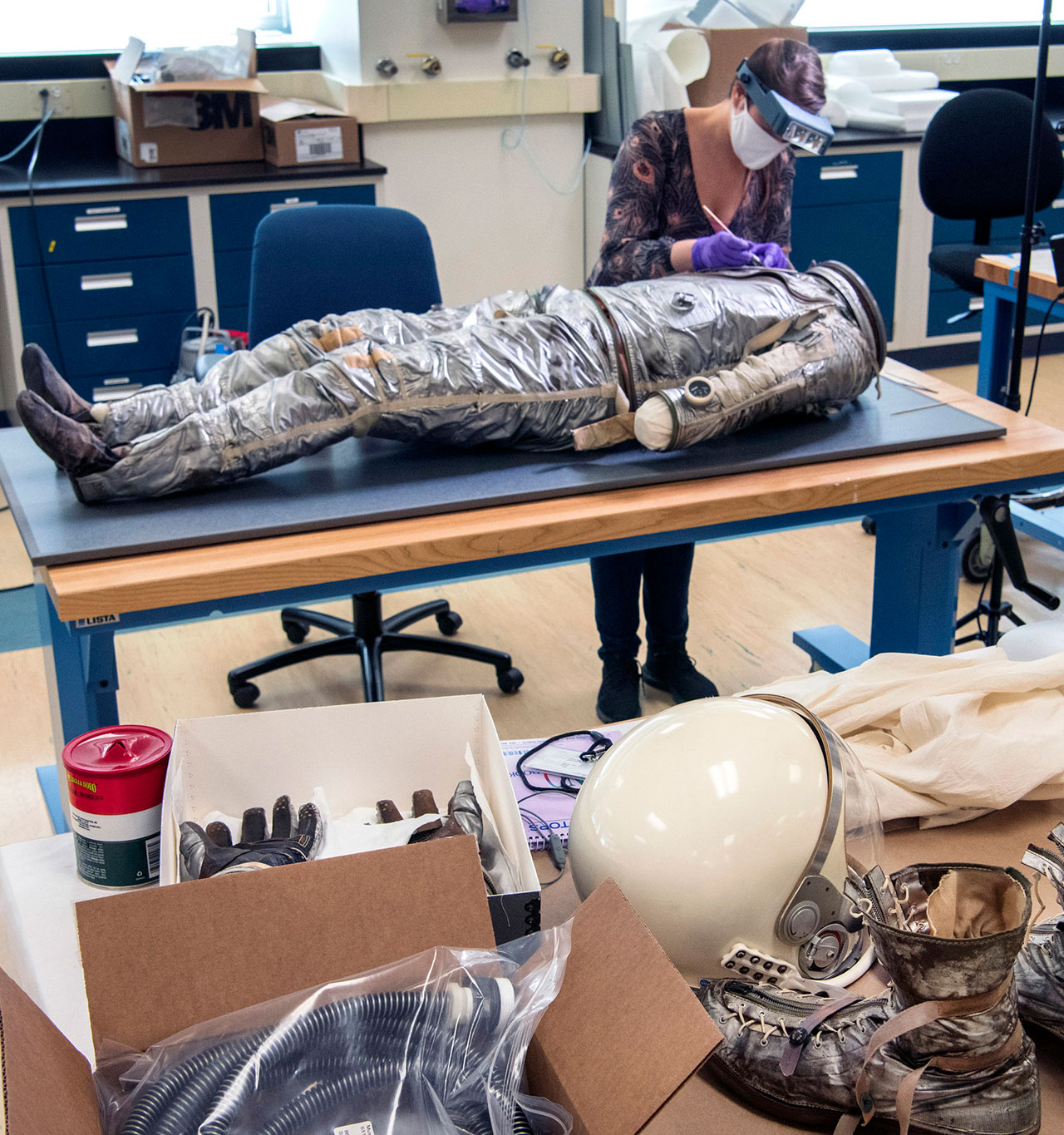Smithsonian inspects first US astronaut's space capsule, suit 60 years on
Conservators have spruced up Alan Shepard's spacesuit and Mercury capsule.

In the 60 years since they made history, astronaut Alan Shepard's spacesuit and Mercury capsule logged more miles than they did on the first U.S. human spaceflight. Now, six decades after they flew, the Smithsonian is preparing both artifacts for their first long-term exhibition together.
Launched on May 5, 1961, Shepard's Mercury-Redstone 3 suborbital mission reached just 115 miles (185 kilometers) high, but the 15-minute flight marked a significant step towards the U.S. catching up with the Soviet Union, which had sent the first satellite and the first human into space. Sometimes overlooked for the longer missions that followed, Shepard's feat on "Freedom 7" — the name he gave his spacecraft — set the stage for the race to the moon.
"This was our earliest space trip in America, and that is a very pivotal moment in history," said Raina Chao, a conservator at the National Air and Space Museum. "We had pivotal moments in flight, and here was the first one in space."
On Wednesday (May 5), the 60th anniversary of its launch, Freedom 7 was set to debut on temporary public display at the Smithsonian's newly reopened Steven F. Udvar-Hazy Center in Virginia. Next year, the capsule and Shepard's spacesuit will be part of the new "Destination Moon" permanent gallery at the National Air and Space Museum on the National Mall.
In photos: Freedom 7, America's 1st Human Spaceflight
Infographic: America's first spaceship: Project Mercury

Capsule condition
Four months after Freedom 7 splashed down, NASA transferred the spacecraft to the Smithsonian. For the next four years, through 1965, the capsule was displayed at the Arts & Industries Building in Washington. It then left the country for exhibits at the Science Museum in London, the Royal Scottish Museum, the World's Fair in Montreal and the Osaka Expo in Japan.
Freedom 7 returned to Washington in 1971, and was in place in the (now-former) "Apollo to the Moon" gallery for the opening of the Air and Space Museum in 1976. It remained there for 20 years and then went to the U.S. Naval Academy in Annapolis, Maryland — Shepard's alma mater — for one month before being held in storage for two years. In July 1998, the capsule briefly returned to public display at the Air and Space Museum as a memorial to Shepard, who had just died of leukemia at the age of 74.
Freedom 7 then spent 14 years in the lobby of the Armel-Leftwich Visitor Center at the Naval Academy before moving to Boston to go on exhibit at the John F. Kennedy Presidential Library and Museum in 2012. Finally, it arrived at the Udvar-Hazy Center in October 2020, to undergo conservation for its future "Destination Moon" display.
Breaking space news, the latest updates on rocket launches, skywatching events and more!
"I found it to be in remarkably good condition," said Chao, who inspected Freedom 7 after its latest road trip. "We were all pleasantly surprised about its condition — particularly about its exterior."

The interior of the capsule, though, showed some signs of degradation. The foam that formed Shepard's support couch has become fragile and is fragmenting.
"I was particularly concerned about the fragmented foam, because any time you move any form of artifact, it's really impossible to prevent vibration, and anything that fragile we just wanted to make sure we weren't losing more of it," Chao said in an interview with collectSPACE. "So I lined all of the edges of that cushion."
"The feet had been lined with tape, seemingly originally, so I took inspiration from that and used a toned paper tissue to line all the edges," she said. "So at least the foam in its fragile state will stay inside that capsule of cushion and not get jostled with vibration and spread out as dust around the capsule."
Chao set up scaffolding to support her as she worked inside Freedom 7. Despite being a space history enthusiast, she had little problem resisting the urge to get in and sit where Shepard had been 60 years ago. Beyond being a very tight fit, there was also a discernible smell.
"It has a kind of new shoe smell, that subtle chemical smell of things that are off-gassing," said Chao. "It was not overpowering, probably because the hatch is not present, so it hasn't been concentrating inside the capsule. So it's a recognizable smell, but I didn't feel like I was going to need a respirator."
The Mercury 7 astronauts: NASA's first space travelers

Suit-able for display
Shepard's silvery Mercury pressure suit followed a different path after its use. It remained NASA property until March 1973, when its title was transferred to the Smithsonian. Even after the change in ownership, though, the spacesuit remained at NASA's Johnson Space Center through 1995 and then was put on exhibit at the adjacent Space Center Houston through October 2000.
The garment then went off public display and was loaned to the National Museum of American History's textile lab for study before being conserved in storage for two years. In 2008, the suit went on display at the American History Museum until arriving at the Udvar-Hazy in 2019.
"I think Shepard's suit, amazingly — maybe because it has been left alone longer — has actually shown better preservation than some of the other Mercury suits that I have seen," said Lisa Young, supervisory conservator at the National Air and Space Museum. "The coating is much more well adhered to the exterior surfaces."
"Even though we had it on display longer, because it was at American History for a long time on display, people haven't been handling the materials, and that does help keep the suit from getting physically distressed," Young told collectSPACE.
Like Freedom 7, there were areas that needed to be protected from further falling apart. The rubber neck dam, for example, which held the suit's connecting ring to the helmet, had a big tear in it.
"I think that was just because of age," said Young. "The polymers are starting to degrade and harden, and so it had gotten a tear."
Similar to what was done for the foam in the capsule, conservation-safe tissues were first color matched and then laid down into the rubber to contain any pieces that might crumble and separate.

"So the suit can continue to be flexible and folded in the configuration you would have for the neck ring, but the public won't see it," Young said.
Shepard's pressure suit will go on display in the new "Destination Moon" gallery adjacent to Freedom 7, each in their own display cases. A crowdfunding effort in 2015 underwrote both the conservation and display of Shepard's suit.
"There isn't one person who we talk to and tell that we are working on the suit and Freedom 7 who isn't excited, and I think that helps our jobs a lot," said Young. "It's very humbling working on these pieces."
Click through to collectSPACE to see more photos of Alan Shepard’s suit and Freedom 7 Mercury capsule undergoing preparation at the Smithsonian.
Follow collectSPACE.com on Facebook and on Twitter at @collectSPACE. Copyright 2021 collectSPACE.com. All rights reserved.

Robert Pearlman is a space historian, journalist and the founder and editor of collectSPACE.com, a daily news publication and community devoted to space history with a particular focus on how and where space exploration intersects with pop culture. Pearlman is also a contributing writer for Space.com and co-author of "Space Stations: The Art, Science, and Reality of Working in Space” published by Smithsonian Books in 2018.
In 2009, he was inducted into the U.S. Space Camp Hall of Fame in Huntsville, Alabama. In 2021, he was honored by the American Astronautical Society with the Ordway Award for Sustained Excellence in Spaceflight History. In 2023, the National Space Club Florida Committee recognized Pearlman with the Kolcum News and Communications Award for excellence in telling the space story along the Space Coast and throughout the world.

